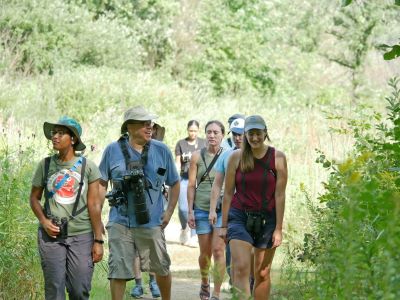Our First Saturday Bird Outings, created as part of our commitment to the Lane Audubon…
 During our walks this March, we have been delighted by the activity of birds preparing for spring. It’s particularly amusing to observe the crows flying overhead and calling boisterously as they choose their evening roosting site. Most people who study birds believe that one function of this gathering process is information exchange, and I wonder what they are saying to one another each evening. Despite the voices, both raucous and melodious, that we hear this spring from our bird neighbors, we are well aware that when it comes to human policy decisions, the birds have no voice and it is up to us to speak on their behalf. Fortunately, what’s good for the health of wildlife is good for the health of people. We need to speak out against the dangerous practice of aerial spraying of chemicals on logged forests because we are concerned about the well-being of people, fish and wildlife, and our waterways and soils.
During our walks this March, we have been delighted by the activity of birds preparing for spring. It’s particularly amusing to observe the crows flying overhead and calling boisterously as they choose their evening roosting site. Most people who study birds believe that one function of this gathering process is information exchange, and I wonder what they are saying to one another each evening. Despite the voices, both raucous and melodious, that we hear this spring from our bird neighbors, we are well aware that when it comes to human policy decisions, the birds have no voice and it is up to us to speak on their behalf. Fortunately, what’s good for the health of wildlife is good for the health of people. We need to speak out against the dangerous practice of aerial spraying of chemicals on logged forests because we are concerned about the well-being of people, fish and wildlife, and our waterways and soils.
Private timber forests are managed under the 1971 Oregon Forest Practices act, which many consider to have the weakest environmental safeguards in the West. The laws have led to protection of timber companies at the expense of people and the environment. Current forest practices mean an increased risk of landslides, erosion, wildfire, and inadequate habitat. Chemical sprays, especially through aerial application, have affected the health of people in our communities and led to the poisoning of area soils, water, and wildlife. Releasing toxins from helicopters means off-target spray, drift, and increased runoff that contaminates neighboring waterways and lands, including farms that practice organic agriculture. The body of scientific documentation on the hazardous effects of commonly used pesticides and herbicides continues to grow. We’ve examined the many ill effects of these toxins on birds in this column previously; see www.laneaudubon.org/sites/default/files/quail_pdf/April2015_Quail_web.pdf.
Last year’s bill that featured commonsense reforms was not enacted in the legislature, largely due to the funded opposition by the logging and pesticide industries. Yet statewide polling found a majority of Oregonians supported the ban. This year, thousands of signatures have been collected in support of three ballot initiatives. All three initiatives make aerial spraying of pesticides and herbicides unlawful “on or near any watershed that serves as a source of drinking water, any school, or any home.” One of the initiatives proposes the elimination of clear-cuts, requiring timber companies to leave 50 trees per acre in western Oregon (15 in the eastern part of the state.) Another restricts logging on steep slopes to reduce the risk of landslides. The signatures have been submitted for verification. In the next phase, we need 88,000 registered voters to sign on to put the measures on the ballot.
Citizens of Lane County are also flocking together to gather signatures to ban the practice of aerial spraying of pesticides here in Lane County. Forests can be well managed without the use of toxins. The US Forest Service has banned the practice on federally owned land for over 30 years. The state and county can likewise do better for its citizens.
So how can we work in chorus to provide a voice for the birds? Educate people about the dangers of aerial spraying of toxins. Encourage people to support forest practice reform! We urge everybody to sign the petitions, to help get these measures on the ballot, and to vote them into law. More information can be found at:
www.beyondtoxics.org/work/pesticide-reform/forestry-pesticide-project/3-proposed-ballot-initiatives-reform/
www.oregonwild.org/
www.freedomfromaerialherbicides.org/ (county)



